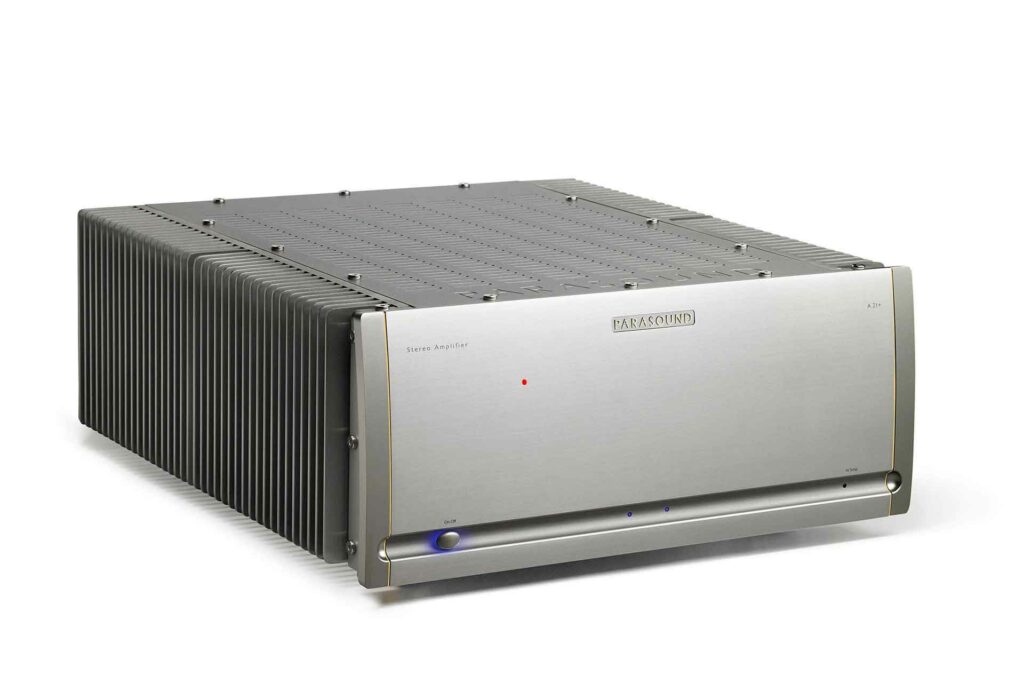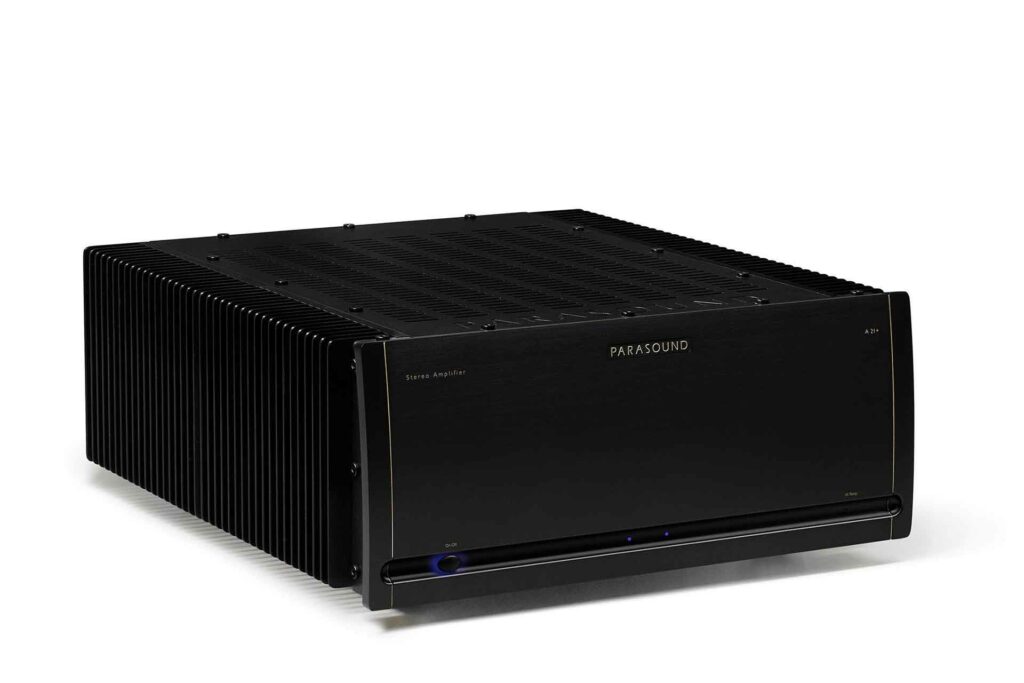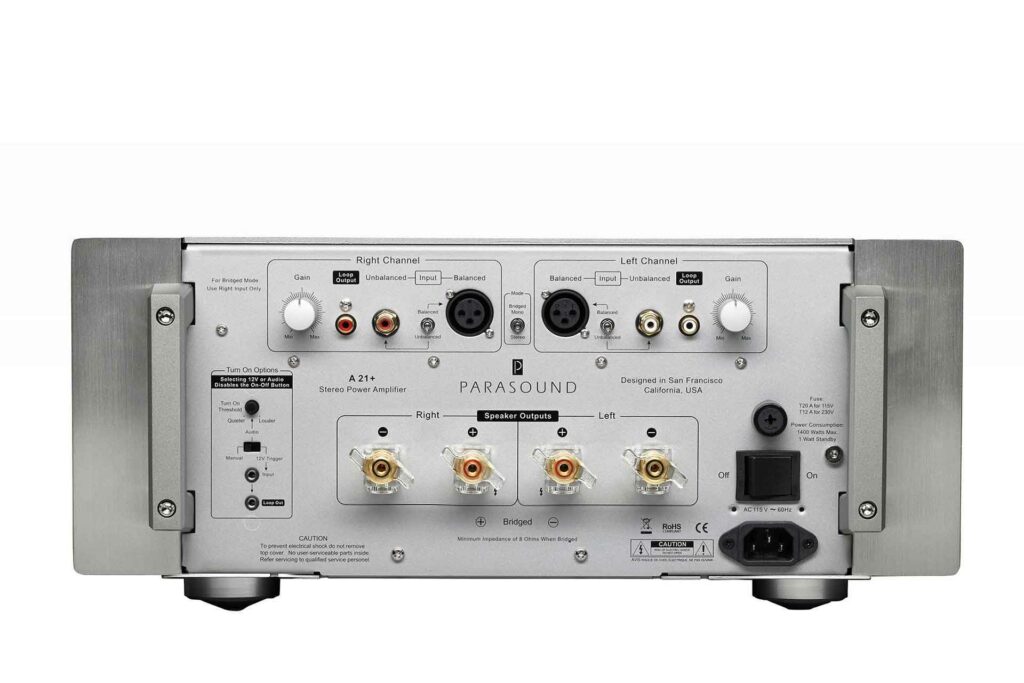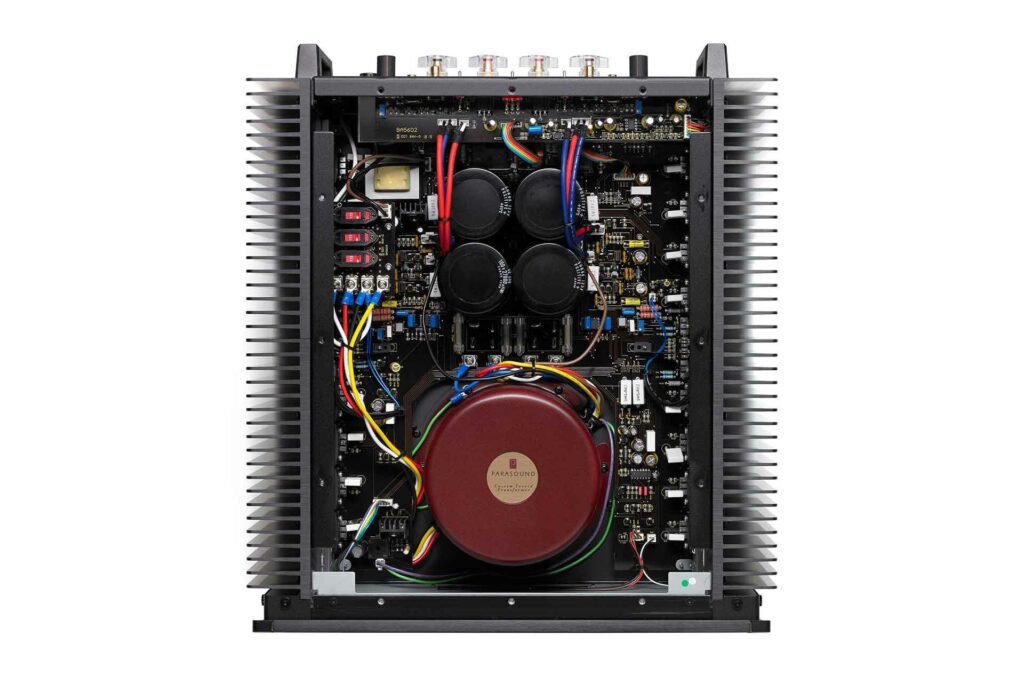For several years, the Parasound Halo A21 reigned as the amplification king in my listening/design space. It was an affordable monster that could drive any speaker one could throw at it. I shorted the outputs of the A21 several times with experimental design work and ran test signals to speakers with extremely low impedance while figuring out acoustic arrays as an at-home speaker engineer. The only time I was nice to my Parasound A21 was when I was sitting back and enjoying my music through finished loudspeakers. The A21 was a stud.
It seems having a 60-pound, bulletproof stereo amplifier in their product line was not good enough for Parasound, so they re-enlisted the legendary John Curl to redesign and upgrade the circuitry of the A 21, and thus was born the Parasound Halo A 21+ (buy at Crutchfield). There were significant upgrades made in the A 21+ that both increased the power capability and lowered the measurable noise. Do these improvements actually amount to a hill of beans in terms of performance over the original, though? Let’s find out.

What Makes the Parasound HaloA 21+ Amplifier Special?
- The Parasound A 21+ is a sophisticated high-current Class A/AB amplifier, meaning it provides Class A power at normal listening levels. All 71 pounds of the A 21+ is dedicated to generating a monstrous 300 watts per channel into 8 ohms and 500 watts per channel into 4 ohms, with 60 amps of current delivery. Most times, serious listening is at conversation level or just above, which means you’ll likely be asking the amp to deliver no more than 10 watts most of the time. But having those power reserves is nice for transients, as well as those times when you want to crank the sound up to dangerous listening levels, however briefly.
- Full power is rated down to 5 Hz for unrestricted bass, and the 0.1-percent THD is rated at full power. These are nerd-out-worthy numbers in a mid-tier audiophile amplifier. Most times, power ratings for amplifiers are restricted in one form or another. They will limit the bandwidth of the rating, sometimes to a single note, or use the peak power before the amplifier detonates to provide a power rating. What’s worse is that many times full power ratings are at 10 percent THD. That is 10 watts of ear-ripping garbage for every 100 watts of power. In comparison, when the Parasound A 21+ is operating at a full 500 watts of power, there are only 0.5 watts of distortion. The difference is akin to the A 21+ being a drink of pure spring water, while a poorly rated amplifier is like drinking from a bioswale behind a factory in Detroit.
- The Parasound A 21+ is rack-mountable, handsome, and well-built. Custom installers love the A 21+ for high-end applications where the equipment must be hidden. The amp has understated looks, and no obnoxiously bright lights on the front panel. Trickle-down design cues from Parasound’s reference JC1+ amplifiers adorn the A 21+, such as the CHK Infinium custom binding posts and gold-plated connectors.
Why Should You Care About the Parasound Halo A 21+?
When writing about the Parasound Halo P 6 preamp/DAC, we talked about the legendary circuit designer John Curl. The A 21+ is designed by John Curl. We will get back to why John Curl design is so important, since there is something that we need to discuss first. Voltage and amplification circuits have been around since the dawn of electronics. This means amplifiers are nothing new, or revolutionary. Bear in mind, amplifiers existed before transistors, which is why we have vacuum tube amps. There are entire amplifiers on single microchips today, as well as plug-and-play modules that anyone with a propensity to tinker in the electronics world can throw in a pretty chassis and sell for whatever they wish.
An amplifier like the A 21+ is important because every component in the design, from the power transformer, to the less obvious items like resistors and capacitors, are selected by a world-class amplifier designer, John Curl, to guarantee affordable, reliable, low-distortion power for the lifetime of the unit. There are no corners cut in the A 21+, and many design elements—such as having no capacitors in the signal path that could color the sound—are difficult to execute properly from a design standpoint. Improperly executed circuits can cause instability in the amplifier that can shorten its lifespan. If the designer of your amp does not have the years of experience John Curl does, you may be getting a great product, but not for very long. Design aside, the end-of-day performance counts, too, and the A 21+ flaunts some features typically seen on much more expensive power amplifiers.
The A 21+ can drive just about any loudspeaker out there, which is not something that you can say about any amp, especially at this price. During its two years spent in my system, the A 21+ has never run out of power or shown signs of being used beyond its capabilities.
When it comes to speakers and subwoofers, we often borrow a phrase from the automotive world: “There’s no replacement for displacement,” which means that if you want thunderous bass, you need to move a lot of air. There’s a similar rule for amplifiers: There is no replacing low-noise power that has the dynamic overhead and power reserves to deliver the inherent dynamics in music. The A 21+ provides this kind of power. The fact that it provides this limitless feel with integrity makes it even more special for its price. This sonic signature is typically only reserved for amplifiers well above the $5,000 price point, with the cost driven by the expense of components to build such an amplifier, and specialized design work to make them reliable. It is here where Parasound’s smart supply chain, combined with John Curl’s expertise, has delivered the strong value of the A 21+.

Some Things You Might Not Like About the Parasound Halo A 21+
- The A 21+ is big and heavy. At 71 pounds and 20 inches deep, consideration needs to be made as to where the A 21+ will physically sit.
- It runs warm and uses significant power while idle. The price paid for the amazing sound is inefficiency. The output devices are always switched on most of the time, and so there needs to be significantly more power dissipated. I would not advise having the Halo A 21+ inside a closed closet or cabinet, and would not stack other components on top of it. Opting to leave the Halo A 21+ on all the time, as is recommended for many solid-state amplifiers, will make a noticeable difference in an electric bill. A little reprieve is that John Curl has designed the amp with an adaptive circuit so when the A 21+ is first started, it automatically adjusts the amplifier’s bias (think if it as throttle control) so there is no sonic difference between a cold amplifier and one that is fully warmed up. If you choose to place the A 21+ into standby mode while not listening, it will consume less than two watts.
- The Halo A 21+ can be bridged as a monoblock amplifier to deliver a whopping 1,000 watts into eight ohms, but four-ohm bridged operation is not recommended. For the most part, this is not the biggest deal, but if one was considering the A 21+ as a high-powered subwoofer amplifier in a dedicated home theater, it may not drive a tough, passive subwoofer in bridged mode but who knows. That is a bit of an odd application of such a fine amplfier.
Listening to the Parasound Halo A 21+ Amplifier…
Let’s go big in every way possible: Big vocals, big bass, on big loudspeakers with dual 10-inch woofers. Big, meaning Lizzo’s Grammy winning hit song “Truth Hurts” off her album Cuz I Love You. In terms of musical complexity, the song is rather sophomoric, but it highlights Lizzo’s powerful vocals, driven by a hard beat that proves she is “100 percent That Bitch,” just as the song says. The A 21+ offers a glimpse into hard-driven music like this, which is reminiscent of why a dance club with a high-fidelity sound system is so much fun.
The A 21+ provided enough power to drive my largest loudspeakers to nightclub levels, and did so with extremely low distortion. The amp truly provides unhindered power that affords a real taste of what the best of large solid-state design has to offer, but at a reasonable price. There may have been a slight blurring of the texture in Lizzo’s voice and piano run. However, this was not a major sin and is somewhat expected at this price point.
Turning to the world of high-resolution, sophisticated music, let’s cue up the HDCD recording of “Fanfare for the Common Man” off Reference Recording’s Copland 100. There are certain big classical pieces that are often disappointing because there just never seems to be a masterful recording available. Since its release in 2000, this is the version of “Fanfare for the Common Man” that is recorded well enough to satisfy even the most critical listener. The A 21+ provides the presence required to capture this beast of a song in all its glory.
From the first strike of the thunderous bass drum and its resulting decay in the hall, the A 21+ established its ability to control powerful dynamics that musically give a sense of being at the performance. The solo trumpet rings out brassy and bright, and the building layers of low brass command your attention while the thunder from the large bass drums continues. One particularly enjoyable aspect the A 21+ was able to deliver was the music hall, regardless of how many musical layers were added to the orchestra.
As with the Lizzo track, there was a little softening of the instrument’s texture, but it was more of a sin of omission than commission. To reiterate: This small shortcoming is expected at this price point, and should not be detractive from the amazing value the A 21+ provides. At no point did the A 21+ begin to thin out sonically. The music feels limitless on the A 21+, all the way to the last note of “Fanfare for the Common Man,” which can be speaker-busting if one is so brave as to try and reproduce it at orchestral levels.
Does the Parasound Halo A 21+ Have Any Resale Value?
There is a lot of Parasound gear out there, and it always does well in the used market. Given that everyone wants large-scale, high-quality power, reselling an A 21+ for 60 percent or more of its original retail should pose no issues well into the future.

Who Is the Competition for the Parasound Halo A 21+?
The A 21+ provides something few amplifiers do at its level: Power and drive that is akin to the best amplifiers available while maintaining low enough distortion. One real threat to the A 21+ is GaN (Gallium Nitride) Class D amplifiers such as the Peachtree GaN400 ($2,499). GaN Class D is the answer for lightweight, low distortion, and high power in a small amplifier. The GaN400 provides 400 watts of power into four or eight ohms, with lower specified distortion than the A 21+. The GaN400 is also half the size of the A 21+, and weighs nearly five times less. To make a bold statement, GaN technology is as revolutionary for amplifiers as the leap was from tube to solid state. GaN is still immature, however, and it will be a while before it can fully move amplifiers like the A 21+ off their thrones.
The Rotel RB-1590 (buy at Crutchfield) is 81 pounds, 350 watts per channel into eight ohms, and has excellent distortion and signal-to-noise specs, making it a competitor to the A 21+. At $3,699, it is $100 more than the A 21+, making it an even closer competitor than the Peachtree GaN400. Interestingly enough, the RB-1590 is four-ohm stable, however Rotel does not provide any specifications on its four-ohm performance. This is relevant, since many of today’s loudspeakers represent a nominal four-ohm load. What is there to hide, Rotel?

Final Thoughts on the Parasound Halo A 21+ Amplifier
The Parasound A 21+ provides a level of power not often found at its $3,500 selling point. Following in the footsteps of its predecessor, the A21, Parasound was able to maintain the bulletproof qualities that made the A21 legendary while adding meaningful improvements that keep it as the benchmark for high power at this budget level.
It may fall a little short of the very best high-power amplifiers out there in terms of overall resolution, but the A 21+ offers a glimpse into that world and should be on the short list of anyone looking to spend $5,000 or less on a dedicated two-channel amplifier.




Thanks for the review. I own an older Curl designed Parasound and everything you describe has been true of their top of the line amps for years. These may be the best value in amp designs on the market.
I agree.
John Curl has been designing great audiophile electronics since the 1970s and his modern Parasound stuff is very good.
Hi Gregg. Thanks for the kind words! I am glad you have had great experiences with Curl amps, too.
This is the amp I aspire to. But GaN, like from Peachtree, is awfully tempting. But since I have the Halo integrated I feel I know the sound signature of Parasound and I very much love it.